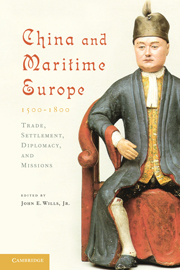Book contents
- Frontmatter
- Contents
- Contributors
- Preface
- Conventions
- Introduction
- 1 Maritime Europe and the Ming
- 2 Learning from Heaven: The Introduction of Christianity and Other Western Ideas into Late Ming China
- 3 Catholic Missions and the Expansion of Christianity, 1644–1800
- 4 Trade and Diplomacy with Maritime Europe, 1644–c. 1800
- Bibliography
- Index
- References
1 - Maritime Europe and the Ming
Published online by Cambridge University Press: 05 June 2012
- Frontmatter
- Contents
- Contributors
- Preface
- Conventions
- Introduction
- 1 Maritime Europe and the Ming
- 2 Learning from Heaven: The Introduction of Christianity and Other Western Ideas into Late Ming China
- 3 Catholic Missions and the Expansion of Christianity, 1644–1800
- 4 Trade and Diplomacy with Maritime Europe, 1644–c. 1800
- Bibliography
- Index
- References
Summary
The Maritime Matrix
The Portuguese conquered Melaka, a loyal Ming tributary, in 1511. Among the many kinds of merchants they encountered there were some who came all the way from the Ryukyu Islands, another small state flourishing on the funneling of trade with China through its tribute embassies. The Chinese were everywhere, even though the Ming state forbade all maritime voyages by Chinese. By this time, the whole structure of prohibitions was bending, but not breaking. The expansion of Chinese illegal maritime trade had produced a flourishing outlaw entrepôt at Yuegang near Zhangzhou in Fujian. In the Zhengde period (1506–1521) ships from Southeast Asian tributary states were allowed to come as frequently as they wished, without regard for the limitations of time and number in the regulations of the tribute system, and their trade was taxed. The Superintendencies of Maritime Shipping (shibosi) were directed by eunuchs, who were especially interested in obtaining rare imports for the palace. The Guangdong Superintendency had a tax-collection station at the distant coastal point of Dianbai in Gaozhou to accommodate this trade, and apparently later at Tunmen in the Canton estuary, the scene of the first encounters with the Portuguese, or at Macao itself. This trade, officially approved but in violation of the basic rules of the tribute system, provided the matrix for the flourishing trade between Siam and Melaka and South China within which the Portuguese began their relations with China. The eunuch superintendents used their positions to obtain extra illicit income for themselves and foreign rarities for the court; the relative openness to maritime trade in the Zhengde reign was very much connected with the domination of a restless nonconformist emperor by his eunuchs, which also was behind the initial acceptance of the first Portuguese embassy and then its rejection after the death of the Zhengde emperor.
The Portuguese Entry, 1514–1524
Vasco da Gama’s voyage around the Cape of Good Hope and the arrival of his ships at Calicut on the west coast of India in 1498 opened a new phase in the history of Asia and, in conjunction with the Columbus voyages to the Americas in the same decade, of the world. The effects of the European intrusion into the Indian Ocean were by no means as overwhelming as those of the Spanish on the Caribbean, Mexico, and Peru; in particular, there was no catastrophic mortality as a result of nonimmunity to Eurasian diseases. Asian maritime traders remained effective competitors of the Europeans on most routes and in most goods until the age of steam, and European political power was confined to small islands and coastal enclaves until the Dutch advances in Java from the 1670s on and the rise of English power in India after 1750. Still, the Portuguese and their successors could be very disruptive. European ships were better gun platforms than those of the Indian Ocean, but it is not clear how often this led to clear naval superiority. More important was the projection of state power onto the high seas, the combination of piracy, naval gunnery, and aggressive efforts to monopolize lines of trade that the Portuguese brought with them from the Mediterranean world. The prosperous and sophisticated network of Muslim maritime trade linking the Red Sea and the Persian Gulf with India and Southeast Asia was only sporadically supported by Ottoman power, and much later by Oman. The Portuguese seriously inhibited the trade of their Muslim rivals until after 1550, when they became more interested in their own intra-Asian trade and more accommodative toward their Muslim competitors. This pattern was mirrored in their relations with China, where early aggressiveness, and no naval superiority at all, led to disaster, while commercial accommodation after 1550 was a brilliant success.
- Type
- Chapter
- Information
- China and Maritime Europe, 1500–1800Trade, Settlement, Diplomacy, and Missions, pp. 24 - 77Publisher: Cambridge University PressPrint publication year: 2010
References
- 4
- Cited by



